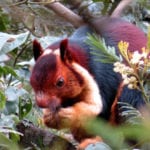 Miscellaneous
Miscellaneous  Miscellaneous
Miscellaneous  History
History 10 Huge Historical Events That Happened on Christmas Eve
 Music
Music 10 Surprising Origin Stories of Your Favorite Holiday Songs
 History
History 10 Less Than Jolly Events That Occurred on December 25
 Weird Stuff
Weird Stuff 10 Funny Ways That Researchers Overthink Christmas
 Politics
Politics 10 Political Scandals That Sent Crowds Into the Streets
 Weird Stuff
Weird Stuff Ten Bizarre Facts About The Doge Meme
 Our World
Our World 10 Ways Your Christmas Tree Is More Lit Than You Think
 Movies and TV
Movies and TV The 10 Coolest Stars to Set Sail on The Love Boat
 History
History 10 Things You Didn’t Know About the American National Anthem
 Miscellaneous
Miscellaneous Top 10 Things Crypto Was Supposed to Change & What Actually Did
 History
History 10 Huge Historical Events That Happened on Christmas Eve
 Music
Music 10 Surprising Origin Stories of Your Favorite Holiday Songs
Who's Behind Listverse?

Jamie Frater
Head Editor
Jamie founded Listverse due to an insatiable desire to share fascinating, obscure, and bizarre facts. He has been a guest speaker on numerous national radio and television stations and is a five time published author.
More About Us History
History 10 Less Than Jolly Events That Occurred on December 25
 Weird Stuff
Weird Stuff 10 Funny Ways That Researchers Overthink Christmas
 Politics
Politics 10 Political Scandals That Sent Crowds Into the Streets
 Weird Stuff
Weird Stuff Ten Bizarre Facts About The Doge Meme
 Our World
Our World 10 Ways Your Christmas Tree Is More Lit Than You Think
 Movies and TV
Movies and TV The 10 Coolest Stars to Set Sail on The Love Boat
 History
History 10 Things You Didn’t Know About the American National Anthem
Top Ten Badass Things That Animals Do
As stated on ourworldindata.org, “You need not look much further than the animal world to find behavior that is truly fascinating.”
One needs only to tune into Planet Earth or open a National Geographic magazine to see animals engaging in quirky, fascinating, or even eerily human-like behavior. Like us, they subvert expectations that others have of them. Like us, they tap into their brainpower to solve complex problems. Like us, they play, work together, form unlikely friendships, mate with members of the same sex, and solve problems in clever ways.
And yet, the way in which they take part in these activities is cause for fascination and intrigue—much more, in my opinion, than their human counterparts provoke. Animals also engage in behaviors that are entirely unique to them, though. For instance, most humans I know wouldn’t roll around in a pile of dust to get clean (like our chicken and chinchilla friends do).
For simplicity’s sake, I’ve boiled down their shenanigans into the ten I find the most interesting and fascinating.
Related: 10 Amazing Ways Animals Are Superior To Man
10 Play
Play isn’t just limited to the dogs you see rolling around together in delightful fur bundles at the local dog park. It’s also observed all across the animal kingdom. White-winged choughs play follow the leader. Chimps in Uganda have been seen entertaining themselves with stick dolls. Naturalists have observed crocodiles providing piggyback rides to smaller reptiles and young elephants utilizing riverside embankments as waterslides. The narrator in My Octopus Teacher observed his octopus friend shimmying her tentacles out toward the fish in her surroundings. She wasn’t trying to hunt them; instead, there seemed to be a playful and whimsical quality to her gestures.
Animals play for all kinds of reasons—learning life skills needed for hunting and breeding behavior, preparing for unanticipated events, and strengthening social bonds among them. And though play is important for social and cognitive development, animals need to be able to distinguish play behavior from real aggression—for which creatures like chimpanzees have a “play face” while dogs have a “play bow,” during which they stick their butt in the air while pressing their forelimbs into the ground.
Ways to tell if an animal is playing are that they repeatedly engage in the behavior of their own volition and when they’re not stressed. And the behavior varies in some way from its more serious version. For example, one type of spider plays at having sex before reaching sexual maturity. What distinguishes the play sex scenarios from the real sex ones is that the females in the former are less likely to eat the males afterward.[1]
9 Form Unlikely Friendships
Examples of unlikely bonds include the bobcat kitten and the fawn, an elephant and a stray dog at an elephant sanctuary in Tennessee, Koko the gorilla with Ball the kitten, and Humphrey the Hippo with the pygmy goat in South Africa. Intra-species animal friendships are more likely to occur in captivity— in part because, as biologist and primate specialist Barbara King notes, “that’s where constraints are relaxed, where the animals aren’t fighting for their basic needs—which allows their emotional energy to flow elsewhere.” However, intra-species animal friendship has also been observed in the wild. All animals have the capacity to form them, regardless of their circumstances.
Researchers have hypothesized that animals form friendships to keep parasites at bay, spot predators, stay warm, and find food. Sometimes one creature instinctually takes a protective or parental role with another. Still, there isn’t always a clear-cut explanation as to why animals form intra-species friendships—just as there’s not always an explanation as to why un-like humans occasionally feel drawn to one another.
What is clear, though, is that “The animals are arguably better off—more confident, physically stronger, in higher spirits—after finding each other than they were before,” writes Jennifer Holland in Unlikely Friendships.[1]
8 Subvert Our Expectations
“There is a great tendency to see an animal do just what it is supposed to do,’ warned the ornithologist Edmund Selous. But ‘uniformity of action’ is in proportion to paucity of observation.”–The Genius of Birds by Jennifer Ackerman
How often have you talked to a human and been pleasantly surprised, or even shocked, to find that their personality contrasted starkly with what you expected of them or what their outward appearance seemed to convey? Like humans do, animals also subvert our expectations.
Take, for instance, otters. They seem cute and cuddly, right? Sure, but according to whidbeynewstimes.com, otters also “produce a strong, disagreeable scent from their anal glands and have especially smelly poop, perhaps from a diet of fish, crab, and other sea creatures.” Humans are also advised to stay away from otters if encountering them in the wild and to never feed them—because, despite their adorable appearance, their bite is worse than their bark.
Similarly, animals that get a bad rap have some admirable qualities going for them. Sharks, for one, aren’t as dangerous as we think. Humans are foreign objects to them. Since we are not a part of their natural ecosystem, they don’t think of us as prey, and when they attack us, it’s [usually] because they’ve confused us with seals. Sharks also use the earth’s magnetic field to travel and keep oceans clean by eating carcasses.
Another expectation-subverting animal: pigeons. If you’re someone who’s written these birds off as worthless rats of the sky, please think again. Pigeons are better than most of us at math (even more adept than some mathematicians!) and can find their way around the world without the GPS we all rely so heavily on these days. Lastly, pigs: though many people associate our porcine friends with squalor, they roll around in the mud—not because they’re dirty—but as a way of cooling off due to a lack of sweat glands.[8]
7 Reversed Gender Roles and Homosexuality
It’s not always the ladies who flaunt their beauty to attract a mate. In the animal kingdom, male peacocks are the ones to court, relying on the ostentatiousness of their grand, colorful tails. Blue-footed boobies woo the ladies of their species by way of a dance that draws attention to their vibrant blue feet. And according to National Geographic, “During mating season, male quetzals grow twin tail feathers that form an amazing train up to three feet (one meter) long.” Beyond appearance, female birds also often judge the mate by the quality of his…singing.
Additionally, bisexuality can be witnessed across many species, as outlined in the book Biological Exuberance. A controversial thing to point out, and one that stands in the face of conservatives’ argument that homosexuality is not natural, but examples of gay animals include the bluegill sunfish, mounting bison, goats, koalas, and ostriches.
In fact, 90% of observed sexual activity amongst giraffes is homosexual. The males, in particular, rub their necks along each other’s bodies, sometimes for hours. Amazon river dolphins were once spotted having gay group sex. This behavior was also studied in Western Australia, where male bottlenose dolphins were seen “hanging out” in groups together after the mating season ended. And, elephants might be considered “homo-romantic” in that, though they may not frequently engage in explicit homosexual sex, they groom, kiss, and lock trunks with all genders of their species.[4]
(Fun fact: My typing “gay bison” into Google to research this sub-section turned up, “Single Lesbian Women in Bison, SD.”)
6 Problem Solving
It’s not just humans who solve problems. Animals, too, show remarkable mental capability. Just because they can’t speak English or communicate in the way we are accustomed to and measure as a sign of cognitive prowess doesn’t mean they lack intelligence. One 2004 study showed young cows’ heart rates increased when they solved problems. Some of these cows even jumped and kicked after encountering solutions! Clark’s Nutcrackers gather thousands of pine nuts every year before burying them in small stashes in separate locations. They then remember exactly where they put them—unlike me with my keys—as well as the quickest, most efficient route to getting to each of them. Crows strip bark off a tree, then bend it into a hook (which they then use to dig out food)!
Pigs performed well in a video game where they had to match shapes with corresponding shapes. They’re so mentally adept, in fact, that pig farmers in Europe are required to keep their swine challenged with mentally stimulating activity, knowing that if these snouted Einsteins become bored, it could lead to aggressive behavior.[5]
5 Cool Hygiene Practices
What to do without a bottle of Head and Shoulders and access to a bathtub or shower? Our animal friends have their own unique ways of staying clean. Bees, for instance, clean themselves while they are flying, using all their limbs to rid their bodies of accumulated pollen. Guillermo Amador, a researcher at the Max Planck Institute, referred to this as the “hovering hygiene strategy.” To keep parasites at bay, capuchin monkeys use substances like limes and onions during their hygiene routine. They even cover themselves in ants and millipedes sometimes!
Elephants and rhinos take mud baths—a practice, I’m sure, any five-year-old child would be down with. Chickens take dust baths, as the dust helps to remove parasites. Animals with fine fur like chinchillas run the risk of getting too cold if they were to take water baths, so they take dust baths too. Like us, bears and tigers bathe in water—the latter are exceptions to the general feline practice of self-bathing with one’s own tongue.
Grooming also doesn’t just serve the sole function of maintaining hygiene. Animals groom each other to strengthen their social bonds as well. Ponies, vampire bats, lions, meerkats, and yellow-billed babblers engage in social grooming (also known as allogrooming), which has been proven to lower the heart rate in macaques and reduce tick load in wild baboons.[6]
4 Bizarre or Unorthodox Sex/Reproductive Practices
Imagine if male and female humans both had vaginas, or all humans had penises! Or maybe not…
In the bird kingdom, however, male and female birds alike have cloacas, which swell during mating season, causing them to protrude slightly out from the body (though they’re less prominent and visible during the remainder of the year). Male birds store their sperm here, while the females receive it in their cloaca before it moves along to fertilize their ova and begin the process of egg formation. They also lay eggs from the same place where they excrete feces and urine. Female ducks can also poop out sperm if they decide they don’t want to have a baby with the male they’ve just mated with. Uh, moving along now…
Another animal with interesting reproductive body parts: the penises of seed beetles contain sharp spikes. Though these spikes sadly physically harm their female partners, it’s been theorized that these spiky penises help anchor the males during sex or scrape away the sperm of her previous partner(thereby increasing the probability of his own sperm inseminating her).[7]
3 Stealth and Camouflage Hunting
Lacking bones, stingrays possess skeletons made of fibrous cartilage—and because they’re flat, they can conceal themselves effectively, hiding beneath the sand. They can’t see their prey after capturing them since their eyes are located on top of their bodies (while their mouths occupy their underside). But similar to sharks, they use smell and electroreceptors in place of sight. Another commonality shared with sharks is coral reefs—the preferred feeding grounds for both species, especially during high tide.
Other animals dirty themselves in order to blend in better with their surroundings when hunting prey. The green lacewing (the aphid’s predator) is one example. Still, others employ subterfuge. The tongue of an alligator snapping turtle, for instance, resembles a worm that, when wriggled around, lures fish who try to eat it (only to be eaten themselves). Flower mantises pass themselves off as flowers to attract prey who come to pollinate on them. And some rat snakes use their tails to seduce prey, which confuses the tails for food.[8]
2 Working Together
An example of hyena collaboration: Researchers constructed a trap door with food inside it and two ropes attached on the outside. Yanking the ropes—which had to be done in unison—would lead to the opening of the trap door and the subsequent release of the food. The hyenas picked up on this, working together to successfully get the food without even needing to be trained to do so. The more experienced hyenas in the pack taught the neophytes the trick to getting the food.
Vizcacha males leave every year while the females stay behind, welcoming new males periodically. They live in communal burrow systems, using branches and heavy objects to cover the entrance. When living close to human settlements, they also hoard garden tools, tables, brooms, concrete pieces, firewood, and trinkets.[9]
1 Make Music
Chirping is a guy thing in the cricket world; the ladies don’t do it. The boys make these harmonious sounds by rubbing their wings against each other. When they rub both their wings and legs together, it’s called stridulation. Heat gives crickets energy, so you’ll hear them chirping faster on hotter nights. You can even estimate the temperature based on the speed of their chorus! The slower the chirp, the lower the temperature.
Male singers are also much more common in the bird world, with male birds producing longer, more complex vocalizations (while female calls tend to be shorter and simpler; an exception to this is in the tropics). Adorably, many species also perform duetting. Other music-making animals include birds, frogs, whales, and dolphins.[10]








